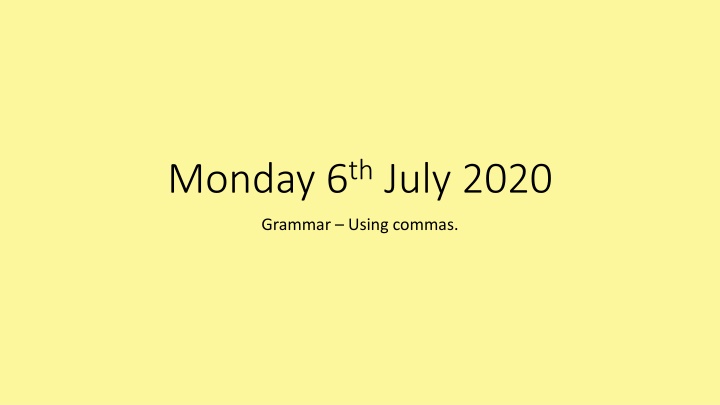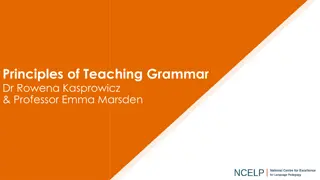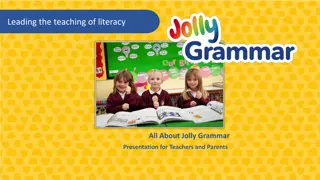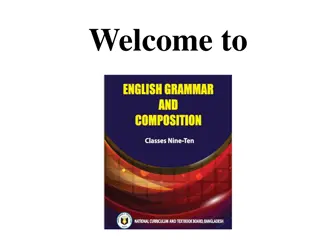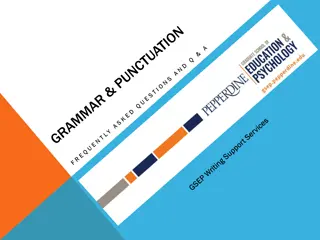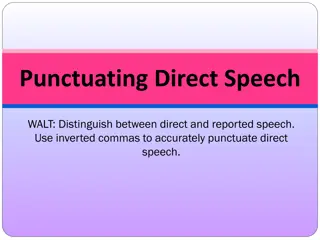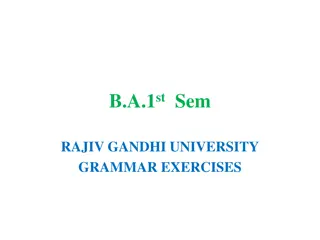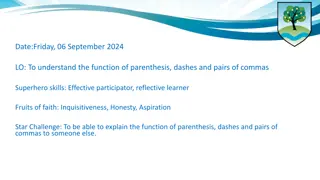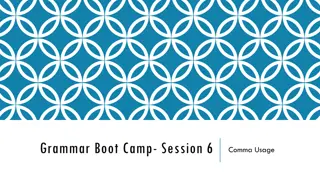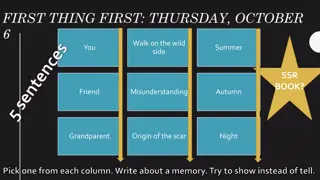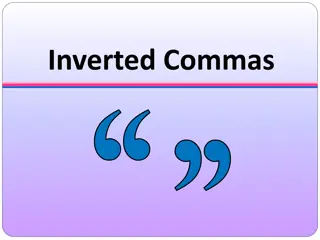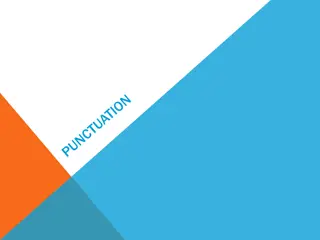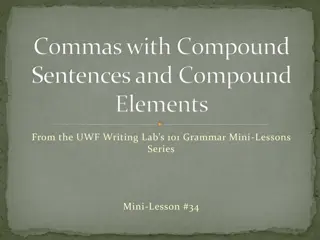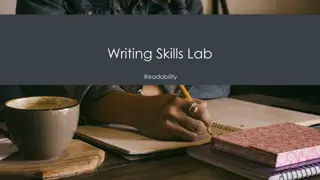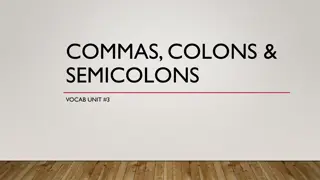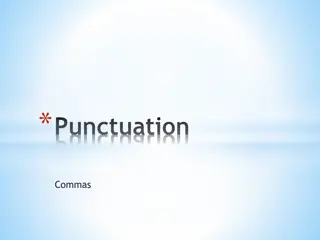Mastering Commas in Grammar: Activities and Practice
Embrace the art of using commas correctly by engaging in various activities and watching informative videos. From understanding the dangers of incorrect comma usage to practicing with quizzes and worksheets, this session focuses on honing your skills. Dive into the world of commas through engaging tasks like creating sentences with extra information and mastering the art of lists. Enhance your descriptive language skills by using the five senses to craft vivid settings. Explore the visual literacy of "Swing of Change" to make intriguing comparisons between past and present. Immerse yourself in a journey of improving grammar and descriptive language through practical exercises and engaging video content.
Download Presentation

Please find below an Image/Link to download the presentation.
The content on the website is provided AS IS for your information and personal use only. It may not be sold, licensed, or shared on other websites without obtaining consent from the author.If you encounter any issues during the download, it is possible that the publisher has removed the file from their server.
You are allowed to download the files provided on this website for personal or commercial use, subject to the condition that they are used lawfully. All files are the property of their respective owners.
The content on the website is provided AS IS for your information and personal use only. It may not be sold, licensed, or shared on other websites without obtaining consent from the author.
E N D
Presentation Transcript
Monday 6thJuly 2020 Grammar Using commas.
Monday 6thJuly 2020 WALT: revise how to use commas. Success Criteria: Watch two videos Complete three activities
Learn Watch the first video to understand why using commas incorrectly can be dangerous! Watch the second video and learn how commas can be used in different ways. Practise Activity 1 Test your knowledge of how to use commas by completing the quiz. Activity 2 Watch this interesting bog snorkelling event from BBC Newsround. Then, write individual sentences with commas to: add meaning add extra information (parenthesis) separate a main and subordinate clause, when the sentence starts with a subordinate clause separate items in a list Top tip! Remember, if the two sentences you are trying to connect make sense on their own, use a full stop to separate them.
Activity 3 Give this fun worksheet (commas for clarity) a try to practise your use of commas. Choose the sheet based on how confident you are: 1 star = you need to practice 2 stars = you feel confident 3 stars = you feel very confident
English Visual Literacy Week Beginning 06/07/2020 Swing of Change
Monday 6thJuly 2020 WALT: use descriptive language to make comparisons. Success Criteria: Use the 5 senses to help create a description. Produce a setting description.
Swings of Change - https://www.youtube.com/watch?v=76Xxn1FSdQ4 Watch the clip to 1:45 and make notes about these questions: When could the film be set? What is his job? How do You know? What can they see inside the shop? What could he have said to the musician? Can you identify links to the past and explain using current day comparisons? What do you make so far about the clip you have seen?
5 senses for description 5 senses for description Think about 5 senses- if you were standing there what might you see/ hear/ smell etc? Have a go at writing a descriptive sentence about the street in the image using the vocabulary you have just collected. A reader should be able to picture in their mind whatever they write. Use a variety of sentence starters.
Look at resource 1a. How does it differ? How can you tell which is set in the past? Can you use comparative language to explain? Repeat the exercise writing a sentence to describe the modern street, also considering the 5 senses and descriptive language.
Writing Task Writing Task Write a setting description using the 5 senses. Write a description of the 1930s street. You should use 5 senses to write a rich description with quality vocabulary within extended sentences. As an extension write a paragraph comparing the setting with the image of the modern street focusing on adverbs for comparison.
Tuesday 7th July 2020 Reading Viper Questions - Film Comprehension Use the Swing of Change discussion guide to answer the questions about the film. https://www.youtube.com/watch?v=76Xxn1FSdQ4
Tuesday 7th July 2020 WALT: add detail to description by using expanded noun phrases, relative clauses and embedded clauses. Success Criteria: User expanded noun phrases. Write a character description. Use a variety of sentence openers.
Swing of change Swing of change - - https://www.youtube.com/watch?v=76Xxn1FSdQ4 Play the clip, pausing at 1:02. What is the physical appearance of the barber. What is he wearing? How can you tell it is 1930s? Does his appearance reflect his job? Can you describe the shape of his face/ body and his physical attributes? Mind map ideas then think about the personality of the barber. How would they describe him as a person? What kind of life does he lead?
There are no right or wrong answers here, make it up and create a personality for him! Add these ideas to your mind map then choose one example to write a sentence, for example: The barber wore a tailored waistcoat. Look at resource 2a and look at the relative clause, now develop the sentence using one. For example: The barber wore a tailored waistcoat which was made from expensive fabric.
Look at resource 2b. Can you have a go at using a mid-sentence relative clause in the same sentence? For example: The smartly dressed barber, who always took pride in his appearance, wore a tailored waistcoat which was made from expensive fabric. Can you rearrange the order of clauses in the sentence to show a variety of different ways it can be written and a range of sentence starters?
Writing Task: Writing Task: Write in paragraphs describing the barber s physical characteristics and personality. Use a combination of extended noun phrases and relative clauses. Show manipulation of clauses and a variety of ways in which to use them for sentence structure.
Wednesday 8th July 2020 Reading KS2 English Vocabulary and Comprehension: Alexander Fleming Activity 1: Create your own poster: In One colour identify unfamiliar words within the text and write them down. Activity 2: In a different colour write next to the word what you think it means. Activity 3 Using a dictionary find the actual meaning of the word and write it in a different colour alongside or underneath the word and meaning you wrote. Read Alexander Fleming Activity 4: Answer the questions about Alexander Fleming .
Wednesday 8th July 2020 WALT: use personification as a method of figurative language. Success Criteria: Explain what personification is. create personification sentences.
Watch the clip from 2:50- 4:13. How does the writer bring the trumpet to life? What human qualities does the animation give the instrument? This is called personification giving an object human qualities. Look at resource 5a. How could these objects be personified?
What is figurative language? Why do writers use it? Can you list methods of figurative language that they are familiar with? Explain that personification falls into this category because the writer gives life to an inanimate object, sometimes by the choice of just one word like a verb. Focus on the trumpet on the clip. Why has the writer chosen this instrument? What is the association with both the barber and the busker to playing a trumpet? (Barber s background as soldier and busker s links to jazz music.)
Think and write down words to describe the trumpet. What does it sound like? Is it solemn or is it playful? How does the instrument lure the barber into playing it? If it could speak what might it say to him to tempt him? Note the magical vibration lines emitting from trumpet in clip- how does this add to the effect of personification of the instrument? Make a list of words and phrases which make the trumpet sound alive. E.g. The mouthpiece danced upon his lips. As the metal warmed in his hand, it felt comforting, like an old friend.
Writing Task: Writing Task: Watch the section of the clip where the trumpet comes to life. Write this section in two paragraphs including at least six. Can you use other figurative language devices?
Thursday 9th July 2020 Reading KS2 English Vocabulary and Comprehension: Who Invented Red and Yellow Cards? Activity 1: Create your own poster: In One colour identify unfamiliar words within the text and write them down. Activity 2: In a different colour write next to the word what you think it means. Activity 3 Using a dictionary find the actual meaning of the word and write it in a different colour alongside or underneath the word and meaning you wrote. Read Who Invented Red and Yellow Cards? Activity 4: Answer the questions about Who Invented Red and Yellow Card
Thursday 9th July 2020 WALT plan and write a story independently. produce a written narrative Success Criteria: Produce a narrative. Use personification and other figurative language. Use expanded noun phrases. Use character and setting descriptions.
Discussion points Why is descriptive language so important to writers? How is this achieved? What purpose do a range of clauses have within a sentence and how can openers be incorporated into this? Do all sentences need to be extended? Think about other characters in the film. How could conversations be integrated into their writing? What have you learnt about the different types of language (figurative/ emotive/ descriptive/ non-verbal) and how has this affected your work and the writer s way of conveying the subliminal message within the film? Think about the play on words in the film title. Where do we see the swing- The pendulum, the switch between uses for the trumpet, the racist views, the change in customers in the shop?
https://www.youtube.com/watch?v=76Xxn1FSdQ4 Watch the film start to finish. Today you will write a narrative independently from the perspective of the barber detailing the events that day. You will begin by giving some background detail to his life and then moving onto the scene at the beginning of the film and chronologically work their way through the events using the writing techniques they have learnt during this unit and drawing on other methods you know which will improve your writing.
Planning How will you stir emotion within the reader? How will you use description to set the scene and tell his story, showing the change in his perception of race and prejudice? What person/ tense will they write in? Can you feature the title within the text? Look resource 10a and allow plan your narrative. IF YOU ARE COMPLETING YOUR INDEPENDENT WRITING IN BOOKS, MISS A PAGE BEFORE STARTING- YOU WILL NEED A BLANK PAGE (BOTH SIDES) THAT SITS OVER THE TOP FOR THE NEXT LESSON
Writing Task: Independent writing Writing Task: Independent writing Write a narrative re-telling the story from the barber s perspective, drawing upon writing techniques learned throughout the week and methods previously taught
